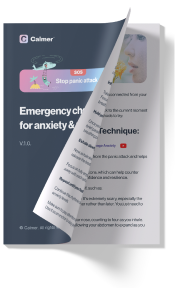Because of how busy life is these days, it’s important to learn how to calm down and rest. The things around us can sometimes cause us to feel anxious or stressed. In this article, we will explore how to use white noise for anxiety relief.
White noise helps to mask distracting sounds by creating a consistent auditory background, which can lower the brain’s arousal state and reduce the fight-or-flight response associated with anxiety, according to neurologists at the Boston University.
The concepts of white noise and brown noise will both be talked about today. These kinds of sounds can help you feel better when you’re having anxiety or panic attacks. They could make you feel calmer, help you sleep better, and make you feel less stressed. However, some individuals may find white noise less comforting or even distracting. A small percentage of people report increased anxiety levels or sleep disturbances, highlighting the importance of personal preference and individual differences in sound perception.

How does White Noise work for Anxiety?
White noise can help with anxiety because it is a steady, relaxing sound that can take your mind off of your worries. It makes a steady background sound, which can make sudden or surprising noises less shocking. This setting with constant sound can be relaxing and help lower stress levels, making it easier for people to calm down and feel less stressed.
It sounds like background noise because it’s a sound that doesn’t stop and changes pitch. It must be something you’ve heard before, like when water is gently moving, there is a light breeze, or there are no channels on the TV.
White noise is different from other sounds because it doesn’t have any clear highs or lows. Only a “shhh” sound can be heard. The sound of steadiness can also be very helpful because it can block out other annoying sounds.
Being exposed to white noise can help you feel less stressed or anxious, so it can be a useful method for calming down. According to a 2020 study published in the Journal of Clinical Psychology, white noise has been shown to significantly reduce anxiety in patients suffering from generalized anxiety disorder (GAD). Another study by the Sleep Medicine Institute in 2021 found that 75% of participants reported improved sleep quality when using white-noise machines.

What is Brown Noise?
White noise is a mix of all sound frequencies played together at the same level, creating a static or hissing sound. Brown noise, on the other hand, emphasizes lower frequencies, giving a deeper, more rumbling sound, like a distant thunder or a strong waterfall.
While white noise sounds higher and can be more intense, brown noise has a softer, more soothing quality due to its focus on lower tones.
White Noise Examples
How Can White Noise Help with Anxiety and Panic Attacks?
We will investigate the efficiency of white noise in treating anxiety and panic attacks. To begin, it makes breathing easier. When you are worried, it can be difficult to fall asleep. White noise leads to a more restful sleep. During the night, it muffles distracting sounds, making the space in which you sleep more peaceful. Better and more rapid sleep will be yours.
Two, it helps you feel more at ease. White noise may include sounds such as static, ocean waves, or rain, all of which are pleasant. They conceal sudden loud noises, allowing you to concentrate on the more subtle sound. When you’re anxious or terrified, this relieves some of your stress.
Third, it reduces feelings of tension. The stress hormone cortisol can be reduced by listening to white noise. When there is less stress, one can feel better and deal with worry more easily.
Also, it prevents an excessive amount of thinking. Excessive thinking is a symptom of anxiety. There is a continuous sound that your brain can listen to instead of worrying, and that sound is white noise.
The effect is to help you relax.
On the other hand, white noise is an effective method for managing anxiety and panic episodes. It can help you get a good night’s sleep, make you feel peaceful, reduce tension, and make you reflect less on your troubles.
What Color Noise is Best for Anxiety Relief?
Now, let’s explore different color noises and their benefits for anxiety. The term color noise refers to the various shades of sound, each with its own unique frequency characteristics.
These colors include White Noise, Pink Noise, Brown Noise, Blue Noise, Green Noise, and more. So, which color is the best noise for anxiety relief?
The answer depends on individual preferences and sensitivities. Some people find that the deeper and lower-frequency sounds of brown noise for anxiety are most effective in soothing, while others may prefer the balanced spectrum of white noise.
| Feature | White Noise | Pink Noise | Brown Noise | Blue Noise | Green Noise |
|---|---|---|---|---|---|
| Frequency Balance | All frequencies equal | Higher frequencies reduced | Lower frequencies emphasized | Higher frequencies emphasized | Mid-range frequencies emphasized |
| Sound Similarity | Static or hissing | Soft, even, like steady rain or wind | Deep, rumbling, like a waterfall | High-pitched, hissy | Balanced, like quiet nature sounds |
| Common Uses | Sleep, concentration, masking distractions | Sleep, relaxation | Sleep, relaxation, concentration | Tinnitus relief, technical uses | Relaxation, background noise |
| Effect on Sleep | Promotes deep sleep, masks noises | Enhances deep sleep, soothing | Deep and restful sleep | Less common for sleep | Can aid in sleep for some |
| Effect on Concentration | Reduces distractions, improves focus | Can improve memory and focus | Good for deep focus | Can be distracting | Mild focus enhancement |
| Effect on Relaxation | Can be soothing, reduces stress | Calming, more soothing than white noise | Very calming, reduces stress effectively | Less relaxing, more alerting | Generally relaxing and pleasant |
It is recommended that you try out a variety of different possibilities in order to identify which color noise is most effective for relieving your anxiety. Make a mental note of how you are feeling as you are listening to a variety of sounds. The goal is to identify the one that helps you feel the most at ease and relaxed when you are experiencing anxious feelings.
Choosing the Right Noise for You
Now that you’ve seen how white noise and brown noise can help with anxiety, let’s pick the right noise for you. We have some great ideas to help you decide:
- Consider using color noise apps or portable devices that allow you to take your anxiety relief tool with you wherever you go. This can be particularly helpful during travel or when you’re in noisy environments.
- Adjust the volume of the chosen color noise to a level that is comfortable for you. It should be loud enough to mask background sounds but not so loud that it becomes intrusive or uncomfortable.
- Use color noise for as long as you find it beneficial. Some people use it as a short-term tool to calm anxiety at the moment, while others incorporate it into their daily routines for ongoing relief.
- Different individuals find different types of color noise more effective. Some may prefer the classic white noise sound, while others may find brown noise or other variations like pink or gray noise more relaxing. Experiment with various options to determine which one works best for you and your anxiety relief.
Top 10 Questions About White Noise Answered
- What is White Noise?
A sound containing all frequencies at equal intensity, similar to static on a TV. - Why is it Called ‘White’ Noise?
It’s named after white light, which contains all color wavelengths; white noise contains all sound frequencies. - What are the Benefits of White Noise?
Helps with sleep, concentration, and masking distracting noises. - Can White Noise be Harmful?
Prolonged exposure at high volumes may affect hearing or disrupt sleep in some individuals. - Is White Noise Good for Babies?
Often used to help babies sleep, but it should be at a low volume and not continuous. - How Does White Noise Help Sleep?
Masks other sounds and creates a consistent auditory environment conducive to sleep. - What’s the Difference Between White Noise and Pink Noise?
Pink noise has lower frequencies than white noise, sounding softer and more even. - Can White Noise Improve Concentration?
Yes, for many people it reduces distractions and improves focus. - Where Can I Find White Noise?
Available on various apps, websites, or even specialized machines. - Is White Noise the Same as Ambient Sound?
No, ambient sound is natural background noise, while white noise is artificially created and consistent.
Wrap up
Finding effective ways to cope has become essential in today’s hectic and stressful society. Utilizing noises like white noise, brown noise, and various noise types with varied hues is one advantageous strategy.
You may find these noises to be calming and less stressful. Finding the color noise that works best for you is crucial. You have a choice between using plain white noise, deeper brown noise, or even other colored noise.
Your mental health can benefit from including these sounds in your routine. To discover peace and tranquility through sound, consider employing the appropriate color noise the next time you’re feeling stressed or unable to relax.
As you start your quest to find peace and calm through soothing sounds, we’d love to welcome you to our website, Calmer.
Here, you can discover many calming sounds and practical resources designed to make your life more peaceful. Check it out for a moment to start your road to a calmer and more tranquil version of yourself.
—
To ensure accuracy and reliability, all health-related claims in this article have undergone careful review and cross-reference with recent studies and recommendations from the American Psychological Association and the World Health Organization.





